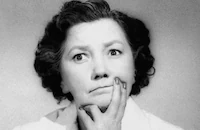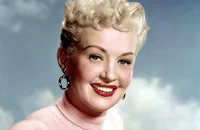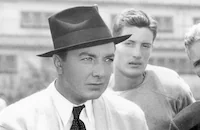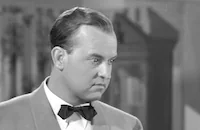Pigskin Parade

Brief Synopsis
Cast & Crew
David Butler
Stuart Erwin
Patsy Kelly
Jack Haley
Yacht Club Boys
Johnny Downs
Film Details
Technical Specs

Synopsis
In a conference room, the board of regents for Yale University tries to decide on what team to play in a charity football game the week before the big Harvard game. Although the University of Texas is chosen, the much smaller Texas State University is mistakenly invited. After two years without a win, Texas State hires a new football coach, Slug Winters, from the East. Slug arrives, but it becomes quickly obvious that his wife Bessie wears the pants and has the brains in the Winters' household. After accepting Yale's invitation, which they assume was offered on account of their new coach, the students rally around the team. Yale, unable to rescind the invitation, sets its publicity man, Sparks, loose, selling the game as the Eastern Goliath versus the Western David. Bessie, learning that the football team is made up of star basketball players, has her husband abandon the standard football running attack for an aerial one, led by star tailback Biff Bentley. The team quickly becomes a huge success, racking up three consecutive wins. At a football rally, Bessie, drunk on a bottle of confiscated gin, accidentally breaks Biff's leg. Desperate for a new tailback, Bessie goes to Fort Smith, Arkansas, to recruit a player, only to learn that he is already at Yale. Bessie drives back with students Chip Carson and Laura Watson, and they stop at a melon patch to discover country boy Amos Dodd tossing melons to his younger sister Sairy. They convince Amos and Sairy to come to Texas State where Amos immediately impresses all with his football prowess. Unfortunately, Amos doesn't impress the academic faction of the school. Chip and his fraternity brothers conspire to have Amos impersonate new student Herbert Van Dyke, a Communist who is serving sixty days in jail for an anarchistic act. With Amos back in place, the team remains undefeated. Campus vamp Sally Saxon gets her claws into Amos, but drops him when she receives a jewelled bracelet from well-to-do Mortimer Higgens. Heartbroken, Amos decides to leave the school, but Bessie comes to the rescue again by having Slug romance Sally, then threaten to name Sally in a divorce suit if she doesn't stay engaged to Amos. The team heads by train for Yale and the big game. After taking a 6-0 lead on Amos' touchdown pass, the Texas offense freezes under blizzard conditions. Late in the fourth quarter, Yale marches down the field and takes the lead 7-6. With time running out, Texas State blocks a Yale punt to set up one final scoring chance. Slug accidentally knocks himself out on the sidelines, putting Bessie in charge. She sends Amos back into the game for the final play. Removing his shoes so he can "feel the earth between his toes," Amos runs through the Yale defense for the winning touchdown. After the game, the Texans parade around the field, as David triumphs once again over Goliath.

Director
David Butler
Cast

Stuart Erwin

Patsy Kelly

Jack Haley
Yacht Club Boys
Johnny Downs

Betty Grable

Arline Judge
Dixie Dunbar

Judy Garland

Anthony Martin

Fred Kohler Jr.

Grady Sutton

Elisha Cook Jr.

Eddie Nugent
Julius Tannen
Sam Hayes
Robert Mcclung
George Herbert
Jack Murphy
Pat Flaherty
David Sharpe
Si Jenks
John Dilson
Jack Stoney
George Y. Harvey
Hal Seiling
Orville Mathews
Ben Hall
Al Klein
Charles Wilson
George Offerman Jr.
Maurice Cass
Jack Best
Douglas Wood
Charles Croker-king
Edward Lesaint
Crew
David Buttolph
William Conselman
Willis Cooper
Bernard Freericks
Roger Heman
Mark Kelly
Victor M. Kelly
Thomas Little
Arthur Miller
Sidney D. Mitchell
Irene Morra
Nat Perrin
Hans Peters
Lew Pollack
Bogart Rogers
Ad Schaumer
Arthur Sheekman
Jack Temple
The Yacht Club Boys
Harry Tugend
Gwen Wakeling
Jack Yellen
Darryl F. Zanuck

Videos
Movie Clip





Hosted Intro
Film Details
Technical Specs

Award Nominations
Best Supporting Actor
Articles
Pigskin Parade
Garland had been signed at MGM through the interest of Louis B. Mayer's executive secretary, Ida Koverman, who discovered her singing with her sisters. The studio tested her and another contract singer, Deanna Durbin, in the musical short Every Sunday, then decided to drop both. Koverman and executive Benny Thau intervened on Garland's behalf, but with no projects under development for the pudgy 14-year-old, the studio loaned her to 20th Century-Fox, her only loan-out during her 15 years at MGM. To loan Garland to Fox, MGM had to turn down another offer for her services from Universal producer Joseph Pasternak, who wanted her to play the youngest of three sisters in Three Smart Girls (1936). With Garland unavailable, he turned to Durbin instead, and the film made her a star while Garland was still languishing in minor roles and singing at studio parties.
It helped a great deal that Pigskin Parade was directed by David Butler, a pioneer in movie musicals who had helped bring Fox's biggest silent female star, Janet Gaynor, into talking films with hits like Sunnyside Up (1929). His work combined graceful camera movements, a quirky sense of humor and a knack for making quieter musical numbers play intimately. Gaynor's rendition of "I'm a Dreamer (Aren't We All?)" in Sunnyside Up had been a revelation to film audiences accustomed to stars like Al Jolson, who belted out songs as though trying to reach the last row of the balcony. He made theatre-goers feel as if the star were singing directly to each of them.
Garland was far from pleased with her comic relief role as Erwin's hillbilly sister, nor did she have any friends on the Fox lot. Fortunately, Kelly took a liking to her and invited Garland to share her dressing room. Though most biographers would agree that her songs in Pigskin Parade were eminently forgettable, the young Garland wasn't. When she sang during location shooting at the Los Angeles memorial Coliseum, her voice was so powerful passersby could hear her on surrounding streets. When she had to perform the ballad, "It's Love I'm After," Garland forgot she was supposed to be a comic character and poured her heart into the song, as she had often done in her vaudeville career. The cast erupted with spontaneous applause and cries of "bravo," ruining the take. At that point, co-star Haley realized he had heard her before, at the Trocadero, and told her she was going to be a big star. They would co-star in Garland's most famous film, The Wizard of Oz (1939), and years later her daughter Liza would marry his son. A fourth Garland number, "Hold That Bulldog," was cut, though the audio is available on the soundtrack CD. Also cut was a duet version of Garland's "It's Love I'm After" sung by Betty Grable and Johnny Downs, because executives didn't want to blunt the effectiveness of Garland's solo. That cut number is also available on CD.
Pigskin Parade also gave Betty Grable more to do than she was getting at her home studio, RKO. There, she had most recently played one of the chorus girls in the Fred Astaire-Ginger Rogers musical Follow the Fleet (1936), a promising part cut to only a few minutes of screen time while the film was readied for release. She actually had to seek out the role in Pigskin Parade on her own, only to be overshadowed by the rest of the large cast. Just to make things worse, RKO let her go after just one more film. She found a new home at Paramount, but it was back at Fox a few years later that she would finally rise to stardom.
Pigskin Paradewas pleasantly received as an amalgam of college musical and sports comedy and did well enough to earn Erwin an Oscar® nomination the first year the Academy® gave awards for supporting players, even though he was top-billed. The Hollywood Reporter noted that preview audiences responded best to Garland's numbers, but the New York Times simply called her "cute, not too pretty, but a pleasingly fetching personality, who certainly knows how to sell a pop." Robert Garland, the New York American reviewer from whom she had taken her professional name, was more perceptive, calling her "a girl to keep an eye and ear on." Garland herself was less than pleased with the film, calling herself a "fat little frightening pig with pigtails." Fox had even dressed her to emphasize her pubescent weight problems. It would mark the beginning of a lifelong struggle with weight that would eventually contribute to the health problems that killed her.
Producer: Darryl F. Zanuck
Director: David Butler
Screenplay: William M. Conselman, Harry Tugend, Jack Yellen
Based on a story by Mark Kelly, Nat Perrin, Arthur Sheekman
Cinematography: Arthur C. Miller
Art Direction: Hans Peters
Score: David Buttolph
Principal Cast: Stuart Erwin (Amos Dodd), Patsy Kelly (Bessie Winters), Jack Haley (Winston "Slug" Winters), The Yacht Club Boys (Student Quartette), Johnny Downs (Chip Carson), Betty Grable (Laura Watson), Arline Judge (Sally Saxon), Dixie Dunbar (Ginger Jones), Judy Garland (Sairy Dodd), Tony Martin (Tommy Barker), Grady Sutton (Mortimer Higgins), Elisha Cook, Jr. (Herbert Terwilliger Van Dyck), Lynn Bari (Football Game Spectator), Alan Ladd (Student).
BW-93m.
by Frank Miller
SOURCES:
The Life of Judy Garland: Get Happy, Gerald Clark

Pigskin Parade
Quotes
Trivia
Notes
While the Variety review credits actors Jed Prouty and Emma Dunn as playing "Mr. and Mrs. Van Dyke," these characters did not appear in the viewed print, nor did these actors receive any onscreen credit. The Variety review also points out that co-eds were shown attending Yale at the beginning of the film, even though the school was all-male at that time. Hollywood Reporter's review points out that this was the feature film debut of Judy Garland, stating that she was a particular hit with the preview audience of this film. This review further notes the appearence in the film of Larry Adler as a mouth organ specialty, though he was not listed in the onscreen credits or CBCS. According to Twentieth Century-Fox press releases, University of Southern California students worked as extras in the production. Press releases also reported that some football scenes were filmed at the Los Angeles Memorial Coliseum. The Twentieth Century-Fox Records of the Legal Department at the UCLA Theater Arts Library state that other location work was done at the Rose Bowl in Pasedena, at Occidental College in Eagle Rock, and in Encino, CA. Train scenes were shot at a railroad station in Chatsworth in the San Fernando Valley. According to various modern sources, Twentieth Century-Fox borrowed Garland from M-G-M for this film, and Ben Silvey was the unit production manager. A modern source states that Eddie Cherkose wrote additional material for the Yacht Club Boys to use in this film.

Miscellaneous Notes
Released in United States 1936
Released in United States 1936














